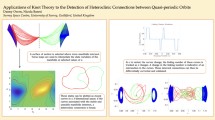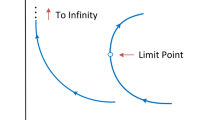Abstract
Venus, Earth’s closest neighbor in the Solar System, shares similar characteristics such as size, density, and location within the Sun’s hospitable zone. As a result, it has been proposed as an ideal destination for a range of missions, including Venus and Mercury planetary science, heliophysics observation, space weather monitoring, and Earth planetary defense. The current study examines exterior and interior resonance of discovered periodic orbits, as well as the creation families of Sun–Venus planar periodic orbits in the Sun–Venus system. The circular restricted three-body problem (CR3BP) is used to generate these orbit families via the method of pseudo-arclength continuation. This study identifies 16 exterior and 22 interior resonant periodic orbits from an initial collection of near-Venus and touring periodic orbits generated via a described grid search method. Next, the study produces a selection of 20 families of Sun–Venus periodic orbits with favorable stability properties that will serve to reduce orbit maintenance and station-keeping costs in terms of propellant expenditure, a primary constraint on spacecraft operational lifetime. This study aims to advance multi-body trajectory research and fill a catalog and wider literature hole by providing a preliminary investigation of Sun–Venus CR3BP periodic orbit resonance and orbit families.














Similar content being viewed by others
Data availability
The datasets generated for the current study are available following the submission and approval of a formal institutional request to the Air Force Institute of Technology (AFIT).
References
Arrhenius, S.: The Destinies of Stars (1918)
Lovett, R.A.: Tidal Heating Shrinks the ‘Goldilocks Zone’. Nature 8, 1–2 (2012)
O’Rourke, J., Treiman, A., Arney, G., Byrne, P., Carter, L., Dyar, D., III, J.H., Gray, C., Kane, S., Kiefer, W., McGouldrick, K., Montesi, L., Russell, C., Smrekar, S.: Venus Goals, Objectives, and Investigations. Technical report, Venus Exploration Analysis Group (VEXAG) (2019)
Zasova, L., Gregg, T., Burdanov, A., Economou, T., Eismont, N., Gerasimov, M., Gorinov, D., Hall, J., Ignatiev, N., Ivanov, M., Jessup, L.K., Khatuntsev, I., Korablev, O., Kremic, T., Limaye, S., Lomakin, I., artynov, A., Ocampo, A., Shuvalov, S., Vaisberg, O., Voron, V., Voronstsov, V.: Venera-D: Expanding Our Horizon of Terrestrial Planet Climate and Geology through the Comprehensive Exploration of Venus. EPSC-DPS Joint Meeting (2019)
Ticku, N.J.: Russia Suspends Pact with NASA on Venera-D Venus Exploration Mission Amid New U.S. Sanctions: ROSCOMOS. https://eurasiantimes.com/russia-suspends-cooperation-with-nasa-on-venus-exploration/. [Accessed 11 July 2023] (2022)
WION: India’s Venus Orbiter Mission ’Shukrayaan’ to Be Carried Out in 2031? [Accessed 16 July 2023]. https://www.wionews.com/science/indias-venus-orbiter-mission-shukrayaan-to-be-carried-out-in-2031-553521
NASA: NASA’s DAVINCI Mission To Take the Plunge Through Massive Atmosphere of Venus. [Accessed 16 July 2023]. https://www.nasa.gov/feature/goddard/2022/nasa-s-davinci-mission-to-take-the-plunge-through-massive-atmosphere-of-venus
Laboratory, N.J.P.: Venus Emissivity, Radio Science, InSAR, Topography, And Spectroscopy: VERITAS. [Accessed 16 July 2023]. https://www.jpl.nasa.gov/missions/veritas
ESA: EnVision Factsheet. [Accessed 16 July 2023]. https://www.esa.int/Science_Exploration/Space_Science/EnVision_factsheet
Vaquero, M., Senent, J.: Poincaré: A Multi-Body, Multi-System Trajectory Design Tool. JPL Open Repository (2018). https://hdl.handle.net/2014/48975
(JPL), J.P.L.: Three-Body Periodic Orbits Database. Jet Propulsion Laboratory (JPL). https://ssd.jpl.nasa.gov/tools/periodic_orbits.html
Restrepo, R.L., Russell, R.P.: A database of planar axisymmetric periodic orbits for the solar system. Celest. Mech. Dyn. Astron. 130, 1–24 (2018)
Restrepo, R., Russell, R.: Periodic Orbit Database. The University of Texas at Austin (2021). https://utexas.app.box.com/v/solarSystemPOdatabase
Dobrovolskis, A.R., Alvarellos, J.L.: Synchronous satellites of Venus. Adv. Space Res. 69(1), 554–569 (2022)
Rawal, J.: Possible satellites of Mercury and Venus. Earth Moon Planet. 36(2), 135–138 (1986)
Anderson, P., Macdonald, M., Yen, C.-w: Novel orbits of Mercury, Venus and Mars enabled using low-thrust propulsion. Acta Astronaut. 94(2), 634–645 (2014)
Wilmer, A.P., Bettinger, R.A., Holzinger, M.J.: Sun–Venus CR3BP, Part 1: periodic orbit generation, stability, and mission investigation. Arch. Appl. Mech. (2023)
Young, A.: Eclipses and the Moon’s Orbit. https://eclipse.gsfc.nasa.gov/SEhelp/moonorbit.html#:~:text=The%20Moon%20revolves%20around%20Earth,to%20405%2C504%20km%20at%20apogee [Accessed 13 Jan 2023] (2012)
Williams, D.: Venus Fact Sheet. https://nssdc.gsfc.nasa.gov/planetary/factsheet/venusfact.html. [Accessed 13 Jan 2023] (2021)
Wiesel, W.E.: Modern Astrodynamics, 2nd edn. CreateSpace, Dayton (2010)
Szebehely, V.: Theory of Orbits. Academic Press, Cambridge (1967)
Liou, J.-C., Zook, H.A., Jackson, A.: Radiation pressure, Poynting-Robertson Drag, and solar wind Drag in the restricted three-body problem. Icarus 116(1), 186–201 (1995)
Jain, M., Aggarwal, R., et al.: Restricted three body problem with Stokes Drag effect. Int. J. Astron. Astrophys. 5(02), 95 (2015)
Vincent, A.E., Perdiou, A.E.: Existence and stability of equilibrium points under the influence of Poynting–Robertson and Stokes Drags in the restricted three-body problem. In: Mathematical Analysis in Interdisciplinary Research, pp. 987–1002. Springer, New York (2022)
Koon, W.S., Lo, M.W., Marsden, J.E., Ross, S.D.: 2. Dynamical Systems, The Three-Body Problem, and Space Mission Design, 3rd edn. (2011)
Wilmer, A.P., Bettinger, R.A.: Lagrangian dynamics and the discovery of cislunar periodic orbits. Nonlinear Dyn. 111, 155–178 (2023)
Howell, K.C., Pernicka, H.J.: Numerical determination of Lissajous trajectories in the restricted three-body problem. Celest. Mech. 41(1–4), 107–124 (1987)
Barrabés, E., Mikkola, S.: Families of periodic horseshoe orbits in the restricted three-body problem. Astron. Astrophys. 432(3), 1115–1129 (2005)
Singh, J., Mrumun Begha, J.: Periodic orbits in the generalized perturbed restricted three-body problem. Astrophys. Space Sci. 332, 319–324 (2011)
Vaquero, M., Howell, K.C.: Leveraging resonant-orbit manifolds to design transfers between libration-point orbits. J. Guid. Control. Dyn. 37(4), 1143–1157 (2014)
Smith, T.R., Bosanac, N.: Constructing motion primitive sets to summarize periodic orbit families and hyperbolic invariant manifolds in a multi-body system. Celest. Mech. Dyn. Astron. 134(1), 7 (2022)
Grebow, D.J., Ozimek, M.T., Howell, K.C., Folta, D.C.: Multibody orbit architectures for lunar south pole coverage. J. Spacecr. Rocket. 45(2), 344–358 (2008)
Parker, J.S., Anderson, R.L.: Low-Energy Lunar Trajectory Design. The Deep-Space Communications and Navigation Systems Center of Excellence. Wiley, New York (2014)
Hoelker, R.F.: Nomology of Earth-Moon Orbits, C=4.00 and C=C(L1). NASA Technical Note (1970)
Wiesel, W.E.: Spaceflight Dynamics, 3rd edn. Aphelion Press, Beavercreek (2010)
Boudad, K.K.: Disposal Dynamics from the Vicinity of Near Rectilinear Halo Orbits in the Earth–Moon–Sun System. Master’s thesis, Purdue University (2018)
Liu, C., Dong, L.: Stabilization of Lagrange points in circular restricted three-body problem: a port-Hamiltonian approach. Phys. Lett. Sect. A: Gener. At. Solid State Phys. 383, 1907–1914 (2019). https://doi.org/10.1016/j.physleta.2019.03.033
Meirovitch, L.: Methods of Analytical Dynamics, 1st edn. (2003)
Connor Howell, K.: Three-dimensional, periodic,‘halo’ orbits. Celest. Mech. 32(1), 53–71 (1984)
Li, X., Qian, Y.-J., Yang, X.-D., Zhang, W.: Stability and bifurcation analyses for exterior resonant families in Earth–Moon system. Results Phys. 31, 104961 (2021)
Yousuf, S., Kishor, R.: Families of periodic orbits about Lagrangian points L1, L2 and L3 with continuation method. Planet. Space Sci. 217, 105491 (2022)
Grebow, D.J.: Generating Periodic Orbits in the Circular Restricted Three-Body Problem With Applications to Lunar South Pole Coverage. Master’s thesis, Purdue University (2006). https://engineering.purdue.edu/people/kathleen.howell.1/Publications/masters/2006_Grebow.pdf
Sheth, D., Thomas, V., Pathak, N.M., Abouelmagd, E.I.: Analysis of exterior resonant periodic orbits in the photogravitational ERTBP. Arch. Appl. Mech. 93(5), 2097–2112 (2023)
Pathak, N., Thomas, V., Abouelmagd, E.I.: The perturbed photogravitational restricted three-body problem: analysis of resonant periodic orbits. Discrete Contin. Dyn. Syst. S 12(4 &5), 849–875 (2019)
Pushparaj, N., Sharma, R.K.: Interior resonance periodic orbits in the photogravitational restricted three-body problem. Adv. Astrophys. 1(2), 25–34 (2017)
Gao, C., Masdemont, J.J., Gomez, G., Yuan, J.: The web of resonant periodic orbits in the Earth–Moon quasi-bicircular problem including solar radiation pressure. Commun. Nonlinear Sci. Numer. Simul. 111, 106480 (2022)
Bonasera, S., Bosanac, N.: Applying data mining techniques to higher-dimensional Poincaré maps in the circular restricted three-body problem. Celest. Mech. Dyn. Astron. 133, 1–32 (2021)
Tricoche, X., Schlei, W., Howell, K.C.: Extraction and visualization of poincaré map topology for spacecraft trajectory design. IEEE Trans. Vis. Comput. Graph. 27, 765–774 (2021)
Brick, J.N.: Military Space Mission Design and Analysis in a Multi-Body Environment: An Investigation of High-Altitude Orbits as Alternative Transfer Paths, Parking Orbits for Reconstitution, and Unconventional Mission Orbits. Master’s thesis, Air Force Institute of Technology (2017)
Escribano, T.M.V.: Spacecraft Transfer Trajectory Design Exploiting Resonant Orbits in Multi-Body Environments. PhD thesis, Purdue University (2013)
Pavlak, T.A.: Mission Design Applications in the Earth-Moon System: Transfer Trajectories and Stationkeeping. PhD thesis, Purdue University (2010)
Van Anderlecht, A.G.: Tadpole Orbits in the L4/L5 Region: Construction and Links to Other Families of Periodic Orbits. Master’s thesis, Purdue University (2016)
McCarthy, B.P.: Characterization of Quasi-Periodic Orbits for Applications in the Sun-Earth and Earth–Moon Systems. Master’s thesis, Purdue University (2019)
Maruskin, J.M.: Dynamical Systems and Geometric Mechanics, 2nd edn. Walter de Gruyter GmbH, Berlin (2018)
Schlei, W.R.: Interactive Spacecraft Trajectory Design Strategies Featuring Poincaré Map Topology. PhD thesis, Purdue University (2017)
Lo, M., Parker, J.: Unstable resonant orbits near Earth and their applications in planetary missions. In: AIAA/AAS Astrodynamics Specialist Conference and Exhibit, p. 5304 (2004)
Funding
The authors declare that no funds, grants, or other support were received during the preparation of this manuscript.
Author information
Authors and Affiliations
Corresponding author
Additional information
Publisher's Note
Springer Nature remains neutral with regard to jurisdictional claims in published maps and institutional affiliations.
Appendix
Appendix
The following tables provide the complete initial position and velocity states, periods, and figure mapping of select members of each orbit family presented in this paper. For all orbit members listed, \(y_0=z_0=0\) and \(\dot{x}=\dot{z}=0\) (see Tables 8, 9).
Rights and permissions
Springer Nature or its licensor (e.g. a society or other partner) holds exclusive rights to this article under a publishing agreement with the author(s) or other rightsholder(s); author self-archiving of the accepted manuscript version of this article is solely governed by the terms of such publishing agreement and applicable law.
About this article
Cite this article
Bettinger, R.A., Wilmer, A.P. & Dahlke, J.A. Sun–Venus CR3BP, part 2: resonance investigation and planar periodic orbit family generation. Arch Appl Mech 94, 625–650 (2024). https://doi.org/10.1007/s00419-024-02542-4
Received:
Accepted:
Published:
Issue Date:
DOI: https://doi.org/10.1007/s00419-024-02542-4




